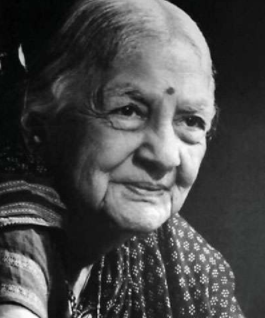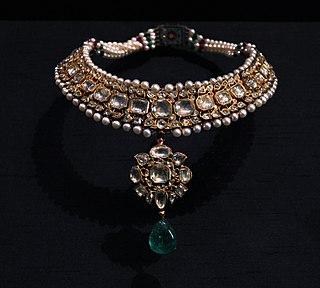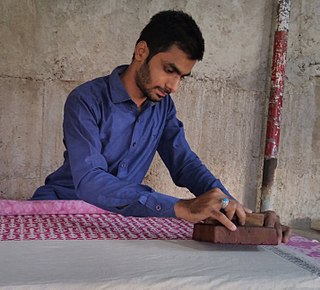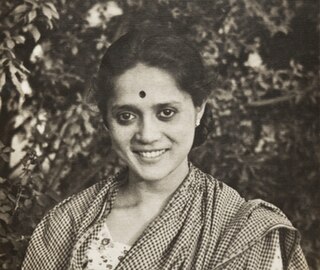Related Research Articles

Chikankari is a traditional embroidery style from Lucknow, India. Translated, the word means embroidery, and it is one of Lucknow's best known textile decoration styles. The main market in Lucknow for Chikankari based products is Chowk. Production is mainly based in Lucknow and in the adjoining districts.

The Meghwal or Meghwar people live primarily in northwest India, with a small population in Pakistan. Their traditional occupation was agricultural farming, cattle-herding and weaving. Meghwals are known for their contribution to embroidery and the textile industry. Most are Hindu by religion, with Rishi Megh, Kabir, Ramdev Pir and Bankar Mataji as their chief gods.

Kamaladevi Chattopadhyay was an Indian social reformer. She has worked for the promotion of Indian handicrafts, handlooms, and theatre in independent India to uplift the socio-economic standard of Indian women. She is the first woman in India to contest in elections from Madras Constituency, but lost.

Pupul Jayakar was an Indian cultural activist and writer, best known for her work on the revival of traditional and village arts, handlooms, and handicrafts in post-independence India. According to The New York Times, she was known as "India's 'czarina of culture'", and founded arts festivals that promoted Indian arts in France, Japan, and the United States. She was a friend and biographer to both the Nehru-Gandhi family and J Krishnamurti. Jayakar had a close relationship with three prime ministers: Jawaharlal Nehru, his daughter Indira Gandhi and her son Rajiv Gandhi, and she was a close friend of Indira Gandhi. She served as cultural adviser to the latter two, confirming her preeminence in cultural matters.

Lakshmi Chand Jain (1925–2010) was a political activist and writer. Later, he served at various times as a member of the Planning Commission, as Indian High commissioner to South Africa, as a member of the World Commission on Dams (WCD) and as secretary of the Indian Cooperative Union and the All India Handicrafts Board (AIHB). His position as the ambassador was terminated as the Vajpayee Government felt that he had not defended India's position on Nuclear tests effectively in South Africa. He eventually joined the Indian National Congress. He was posthumously awarded Padma Vibhushan, the second highest civilian award, by the UPA government. However his family declined to accept the award, saying that Jain was against accepting State Honours.

The National Handicrafts and Handlooms Museum (NHHM) commonly known as National Crafts Museum in New Delhi is one of the largest crafts museums in India. It is run by the Ministry of Textiles, Government of India. The museum is situated on the corner of the Pragati Maidan, facing the Purana Quila complex. In 2015, the Government of India announced that a Hastkala (handicrafts) Academy would be established in the museum premises, converting some galleries into classrooms. Initial renovations destroyed one of the museum's most well-known artifacts, a room of murals painted by Madhubani artist Ganga Devi, leading to widespread criticism. As of 2019, renovations are still ongoing.

Kundan, meaning pure gold, is a traditional form of Indian gemstone jewellery involving a gem set with a gold foil between the stones and its mount, usually for elaborate necklaces and other jewellery.
Jyotindra Jain is an Indian art historian and cultural historian, and museologist. A scholar on folk and ritual arts of India, he was the director of the National Crafts Museum, New Delhi, member secretary and professor, at Indira Gandhi National Centre for the Arts (IGNCA), New Delhi, and also professor at the School of Arts and Aesthetics at Jawaharlal Nehru University, Delhi. He has published a number of books on Indian folk art, including, Ganga Devi: Tradition and Expression in Mithila Painting, Other Masters: Five Contemporary Folk and Tribal Artists of India and Kalighat Painting: Images from a Changing World.

Kalamkari is a type of hand-painted cotton textile produced in the Indian state of Andhra Pradesh. Only natural dyes are used in Kalamkari, which involves twenty-three steps.

The crafts of India are diverse, rich in history, culture and religion. The craft of each state in India reflect the influence of different empires. Throughout centuries, crafts have been embedded as a culture and tradition within rural communities.
Laila Tyabji is an Indian social worker, designer, writer, and craft activist. She is one of the founders of Dastkar, a Delhi-based non governmental organization, working for the revival of traditional crafts in India. She was honored by the Government of India in 2012 with the Indian civilian award of Padma Shri. She is the daughter of late Badruddin Tyabji, ICS, who was a senior Indian civil servant and diplomat.

Meera Mukherjee (1923–1998) was an Indian sculptor and writer, known for bringing modernity to the ancient Bengali sculpting art. She is known to have used innovative bronze casting techniques, improving the Dhokra method employing Lost-wax casting, which she learnt during her training days of the Bastar sculpting tradition of Chhattisgarh. She received the fourth highest civilian award of the Padma Shri from the Government of India in 1992 for her contributions to Arts.

The Kutch Embroidery is a handicraft and textile signature art tradition of the tribal community of Kutch District in Gujarat, India. This embroidery with its rich designs has made a notable contribution to the Indian embroidery traditions. The embroidery, practiced normally by women is generally done on fabrics of cotton, in the form of a net using cotton or silk threads. In certain patterns, it is also crafted over silk and satin. The types of stitches adopted are “square chain, double buttonhole, pattern darning, running stitch, satin and straight stitches”. The signature effect of the colorful embroidery sparkles when small mirrors called abhla are sewn over the geometrically shaped designs. Depending on the tribal sub groups of Rabari, Garasia Jat, and Mutava involved with this craft work many hand embroidered ethnic styles have evolved. These six styles: Suf, khaarek, paako, Rabari, Garasia Jat, and Mutava.
Kamala Sunderrao Kulkarni Dongerkery (1909–1992) was an Indian social worker, art historian, author, and cultural historian. She wrote books on Indian embroidery, Indian jewelry and Indian toys. She also wrote an autobiographical account of her life, On the wings of time (1968).
Suraiya Hasan Bose was an Indian textile conservator, textile designer, and manufacturer, who worked to preserve traditional Indian textile art and techniques. She worked with the Indian Cottage Industries Emporium, as well as the Indian Handloom and Handicrafts Export Corporation, later establishing her own textile manufacturing unit to create traditional Indian textiles. Her designs have been exhibited in the Victoria and Albert Museum.
The All India Handicrafts Board (AIHB), was an organisation in India established in 1952, which aimed to advise the Ministry of Textiles on development programmes for handicrafts. Its early key figures included Pupul Jayakar, Kamaladevi Chattopadhyay, Lakshmi Chand Jain and Fori Nehru. It was abolished by the Government of India in 2020 during the COVID-19 pandemic.
Nelly Homi Sethna was an Indian weaver, textile designer, researcher, writer and a crafts activist. She worked on the crossroads of Scandinavian modernism and Indian crafts tradition, which shaped her guiding philosophy. Her close association with Kamaladevi Chattopadhyay played an important role in the revival and promotion of traditional Indian crafts.

Kitty Shiva Rao, was a Montessori teacher and theosophist from Austria who, by India's independence, had led a committee of women to draft an Indian Women's Charter of Rights and Duties for the new constitution of India. She studied child education and served on several women's movement and education boards including the All India Women's Conference (AIWC), All India Handicrafts Board, Indian Council for Child Welfare and Delhi University Board.

Aditi Ranjan is an Indian textile designer, educator and researcher involved in the field of Indian crafts. She taught textile design at the National Institute of Design, Ahmedabad from 1974 to 2012. Ranjan is known for her book Handmade in India: A Geographic Encyclopedia of Indian Handicrafts based on Indian arts & crafts that she edited along with her partner and fellow design pedagogue, M. P. Ranjan.

Talim in textiles is a symbolic code and system of notation that facilitates the creation of intricate patterns in fabrics, such as shawls and carpets, and the written coded plans that include colour schemes and weaving instructions. The term is used in traditional hand-weaving in the Indian subcontinent. Talim was initially used to create certain types of patterns in Kashmiri shawls, and later came to be applied in the
References
- 1 2 "India in the 1940s: The way we were". Hindustan Times. 10 August 2013. Archived from the original on 11 August 2013. Retrieved 9 October 2014.
- ↑ "Remembering Jasleen Dhamija, India's custodian of crafts (1933-2023)". The Indian Express. 16 March 2023. Retrieved 26 September 2023.
- 1 2 Labonita Ghosh (29 October 2001). "Jasleen Dhamija looks beyond embroidery at the people responsible for it". India Today. Retrieved 9 October 2014.
- 1 2 Sangeeta Barooah Pisharoty (23 July 2014). "Drapes and divinity - The Hindu". The Hindu . Retrieved 9 October 2014.
- 1 2 "Jasleen Dhamija" (PDF). Sutra Textile Studies. Archived from the original (PDF) on 14 October 2014. Retrieved 9 October 2014.
- ↑ Damayanti Datta (16 January 2009). "The interpretation of yarns". India Today. Retrieved 9 October 2014.
- ↑ Dhara Vora (1 September 2014). "Weaving holy traditions". MiD DAY. Retrieved 9 October 2014.
- ↑ "Of people and places: Jasleen Dhamija". Indian-seminar. 2002. Retrieved 9 October 2014.
- ↑ Janani Sampath (3 November 2012). "South has preserved crafts successfully so far". The New Indian Express. Archived from the original on 26 October 2014. Retrieved 9 October 2014.
- 1 2 "Dhamija, Jasleen". craftrevival.org. Archived from the original on 14 February 2014. Retrieved 9 October 2014.
- ↑ "Paperback Pickings". The Telegraph - Calcutta. 16 March 2007. Archived from the original on 9 October 2014. Retrieved 9 October 2014.